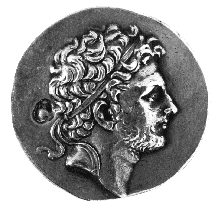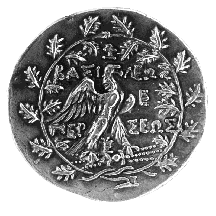



(44) Macedon, Perseus - AR tetradrachm, 171-168 B.C., 15.54 g.
(inv. 91.061).
Obverse: Bearded and diademed head of Perseus r.
Reverse: In oak wreath, eagle on thunderbolt r.; monograms
above eagle and in r. field; below wreath, plough; ![]()
![]() : of King Perseus.
: of King Perseus.
Provenance: Ex Fred V. Fowler collection; Stack's, 1969.
Bibliography: N. Davis and C.M. Kraay, The Hellenistic
Kingdoms: Portrait Coins and History (London 1973) 228-229.
Perseus, the last Macedonian king, succeeded his father, Philip V, in 179
B.C. From the beginning he was careful in securing allies against his greatest
threat, Eumenes II of Pergamon. He renewed a treaty with Rome, which treated
him as an ally until Eumenes convinced Rome to declare war against Perseus
in 171 B.C. The conflict dragged on for three years, until the Roman commander,
Aemilius Paullus, confronted Perseus at Pydna in Macedonia, where the Macedonian
army was slaughtered. Perseus eventually surrendered to the Romans and died
in captivity in Rome. Macedonia was divided into four powerless republics,
and the kingdom of Alexander the Great ceased to exist.
The portrait on the obverse is presumably realistic, since it includes distinctive
features such as the sloping forehead, prominent nose, and short, wispy
beard, and has few of the idealizing qualities common to Hellenistic coin
portraits inspired by those of Alexander the Great. The eagle on the thunderbolt
and the oak wreath of the reverse refer to Zeus, a patron deity of Macedonian
royalty since Alexander.
The relatively light weight of this tetradrachm suggests that it was issued
while Perseus waged war with Rome, since at the end of his reign he apparently
reduced the weight standard of the coins in order to meet the financial
demands of paying his army.
K.J.B.



All contents copyright (c) 1996.
Lawrence University
All rights reserved.